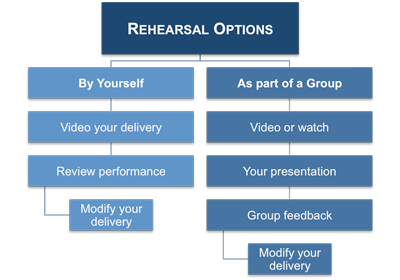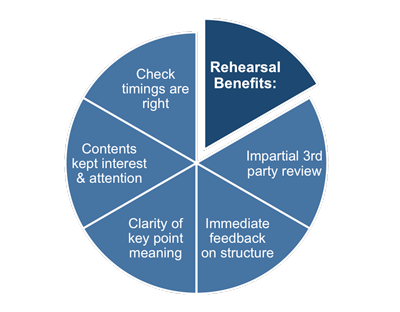Communication Skills - How to Rehearse
The only way to develop your delivery skills is through continual practice, criticism, and revision. That criticism can be self-criticism and in the early stages this is undoubtedly the easiest way. Another relatively painless way is to come to an arrangement with one of your colleagues that you will critique each other's presentations. These critiques should concentrate on those areas that were good as well as those that were weak.
The idea of practicing in front of an audience fills most people with dread. This is made worse when the audience consists of people we work with because no one enjoys all of their shortcomings being discussed by their co-workers.
Remember that any presenter who appears knowledgeable, confident, and enthusiastic about their subject will be forgiven even if their delivery style is not perfect.
 |
When trying to improve your delivery do not try to choreograph every single part of it. The more you consciously think about your body language, eye contact, tone of voice, and avoidance of filler phrases the less natural your delivery will appear. The most important thing is simply to eradicate your worst mannerisms and then concentrate on knowing the topic of your presentation sufficiently well so that you can present it with confidence.
This means that you have two options if you want to improve your delivery style. The first of these, and the most straightforward, involves simply videoing yourself with no audience whilst presenting directly to the camera and reviewing your performance with the intention of eradicating your most annoying mannerisms. Most people will see radical improvements after just a few sessions. You don't need an expensive video camera to do this. Even the cheapest cell phones have a video camera built in and you can simply Velcro one to a wall and use it to record yourself.
The second option is to join with a group of like-minded people who want to improve their public speaking skills. This can take you much further because not only will you actually be performing in front of an audience, but also there will usually be experienced help available.
Even if you do not feel as though you want to invest the time and effort in joining a group of people you should at least use the first option. The fact is that most people who have not taken steps to eradicate annoying mannerisms will usually exhibit one or two things that detract from the message they are trying to get across.
Most people who have never seen themselves deliver a presentation realize after a few minutes in front of an audience that they are using some verbal mannerism that the audience finds irritating and they try to stop doing it in real time. They usually end up simply swapping one mannerism for another, or they become so preoccupied with avoiding that particular behavior that they lose their concentration, their delivery suffers, and the message is lost.
There are several benefits you can attain by rehearsing a presentation at least once before doing it in front of an audience. Practice will help you with your transitions from one point to the next - it is sometimes only through going through the presentation aloud that you realize that your transitions are not as clear as they could be. Practice helps you to test your explanations of difficult concepts so that by the time you give the presentation all of the words are there when you need them.
 |
Remember, even if you are only giving a presentation once, by rehearsing it before the event you give yourself time to develop your overall presentation skills, not just the content. Once you are comfortable with your content and the material behind it, you can practice your delivery by recording it on a cheap video camera or your cell phone.
Set the camera up in such a way that you can film your full body and work through the first point in your presentation. View this critically and eliminate any annoying habits you may have - for example, the use of stock phrases or non-words, or inappropriate body movement.
If you work through the whole presentation this way not only will you become familiar with how it comes across to the audience, you can also eradicate any distracting habits you have seen on the video one by one. In this way, not only do you practice the presentation in question, you also improve your general presentation skills.
It is important to perform at least one full rehearsal of your presentation, using the cue cards that you have prepared. This will highlight any areas of weakness, any items that strike you as being out of sequence, and any cue cards that fail to trigger the spontaneous flow that you had planned. If you make any major changes to the presentation following this rehearsal then you should perform another rehearsal - at least to cover the areas that have been changed.
One reason for practicing your presentation out loud and in front of the camera if possible is that it will give you a clear indication as to whether or not your planned timing is realistic. Generally speaking, once you begin a live presentation you're likely to take longer than you did in rehearsal. This is because you will react to any indication that the audience is not following you with a more detailed explanation or a different form of words.
In addition, it may become clear that whenever you put a slide up the audience requires a certain amount of time - usually somewhere between 10 and 30 seconds - to become orientated as to what the slide is trying to say. You will often discover that when you change slides it feels unnatural to begin speaking straightaway and that you really need to give the audience this time to orientate themselves before you begin either describing the contents of the slide or saying what conclusions can be drawn from it.
You may also be interested in:
Giving a Management Presentation | Styles of Presenting | Cue Card Guidelines | Developing a Persuasive Delivery Style | Reading Your Audience | Retaining Control in a Presentation | Question and Answer Session | Importance of the Presentation Venue | Presentation Venue Layout.



